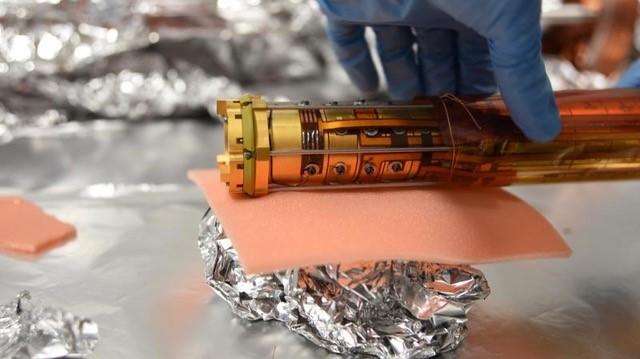March 5, 2020
UCalgary researchers help international team with first-ever measurement of small quantum effect in antimatter

New research on antimatter is moving science closer to potentially solving one of the Universe’s greatest mysteries. In a new experiment, ALPHA has reported the first measurement of small quantum effects in antihydrogen – hydrogen’s antimatter counterpart – and their findings show that, at least in this instance, the atoms show similarities.
The ALPHA collaboration is a world-leading international collaboration operating at the CERN laboratory near Geneva, Switzerland, and includes researchers from the Department of Physics and Astronomy in the Faculty of Science.
ALPHA’s most recent experiment on antimatter sought to determine if any differences existed between the properties of hydrogen and antihydrogen.
- Photo above: University of Calgary's Robert Thompson with PhD student, Andrew Evans. Photo by Riley Brandt, University of Calgary
The results, described in a paper recently published in the journal Nature, show that these first measurements are consistent with theoretical predictions of the effects in normal hydrogen. Essentially, antimatter hydrogen has the same “quantum quirk” as normal hydrogen. Studying these small effects could reveal differences between the behaviour of matter and antimatter.
“This work is the first experimental measurement of the Lamb shift in antihydrogen and finds that, within the precision of our experiment, this shift is identical to that of regular hydrogen. This work confirms that this key element of quantum electrodynamics also holds in antimatter and represents an important step in our understanding of antimatter,” says Dr. Tim Friesen, PhD, assistant professor in the Department of Physics and Astronomy.
UCalgary made essential contributions to discovery
Dr. Robert Thompson, PhD, UCalgary’s Associate Vice-President (Research) and Director of Research Services, is a longtime ALPHA team member and researcher who is leading the coordination of the University of Calgary’s contribution to ALPHA’s antimatter experiments.
“When ALPHA started, we were often viewed as a little different, thinking we could store antihydrogen. Then we did it. After that, people were skeptical that we could detect a spectroscopic signal – we proved we were able to do that, too. Now, work like this shows that we are pushing precision spectroscopy of antihydrogen to levels that will test the foundations of subatomic physics,” he says.
The Faculty of Science workshop fabricated major portions of the cryostat, a liquid helium cooled ultra-high vacuum chamber used to cool the antihydrogen trap to four degrees above absolute zero Kelvin.
Thompson’s PhD student, Andrew Evans, was instrumental in the success of this experiment from start to finish. He was part of the small team that developed and operated the laser system and its complex interface with the ALPHA antihydrogen trap. Andrew also wrote the software to compile and analyse the data.
“The main challenges were keeping the laser running, testing and troubleshooting the experimental equipment, and writing software used in compilation of the datasets,” Evans explains. “So many different parts needed to be working perfectly, and all at the same time, in order for this set of data to be taken. It took a lot of paranoia and last-minute panics to get everything just right.”
Friesen built the trap that was used to combine the positrons and antiprotons to form antihydrogen atoms. During these measurements, Friesen was also the Technical Coordinator for the ALPHA experiment, and was responsible for overseeing upgrades, modifications, and operations of the experimental equipment.

Penning trap, designed to combine the positrons and antiprotons to form antihydrogen atoms.
Contributed
Measurement important step in advancing understanding of antimatter
Physics dictates that for every particle of matter there is an oppositely charged antiparticle with an equal mass. An antihydrogen atom should have the exact same charge as hydrogen (zero). That’s because the antiproton and antielectron (positron), which make up antihydrogen, have the exact opposite charge of the proton and electron that make up hydrogen.
Historically, antimatter particles have been difficult to study, as they can only be made travelling close to the speed of light. When antimatter and matter particles come into contact with each other, they annihilate in a flash of energy.
The ALPHA team creates antihydrogen atoms by binding antiprotons delivered by CERN’s Antiproton Decelerator with positrons, which are then confined in a magnetic trap in an ultra-high vacuum, preventing them from coming into contact with matter and destructing. Laser light is then shone onto the trapped atoms to measure their spectral response. This technique helps measure known quantum effects like the so-called fine structure and the Lamb shift, which correspond to tiny splittings in certain energy levels of the atom, and were measured in this study in the antihydrogen atom for the first time.
“The observation of the Lamb shift in hydrogen in 1947 was a pivotal measurement in modern physics,” Friesen explains. “It showed that there was a small unexpected energy difference between two electron orbitals. This inspired the development of quantum electrodynamics, the theory that describes how light and matter interact.”
ALPHA is now constructing a new vertical antihydrogen apparatus, known as ALPHA-g, to measure whether antimatter will fall exactly like matter in Earth’s gravity.
The laser system used in this work can also be applied to laser cool large samples of antihydrogen, which will allow ALPHA to study antihydrogen at much higher levels of precision.
ALPHA-g is a Canada Foundation for Innovation project led by the University of Calgary, with funding provided by Canada, including contributions from Alberta, British Columbia, and Ontario.
Modern physics states that the universe is made up of equal amounts of matter and antimatter. Researcher Dr. Rob Thompson, PhD, UCalgary’s Associate Vice-President (Research) and Director of Research Services, explains his quest to learn about the universe's most elusive particles.
Explore UCalgary (explore.ucalgary.ca)
